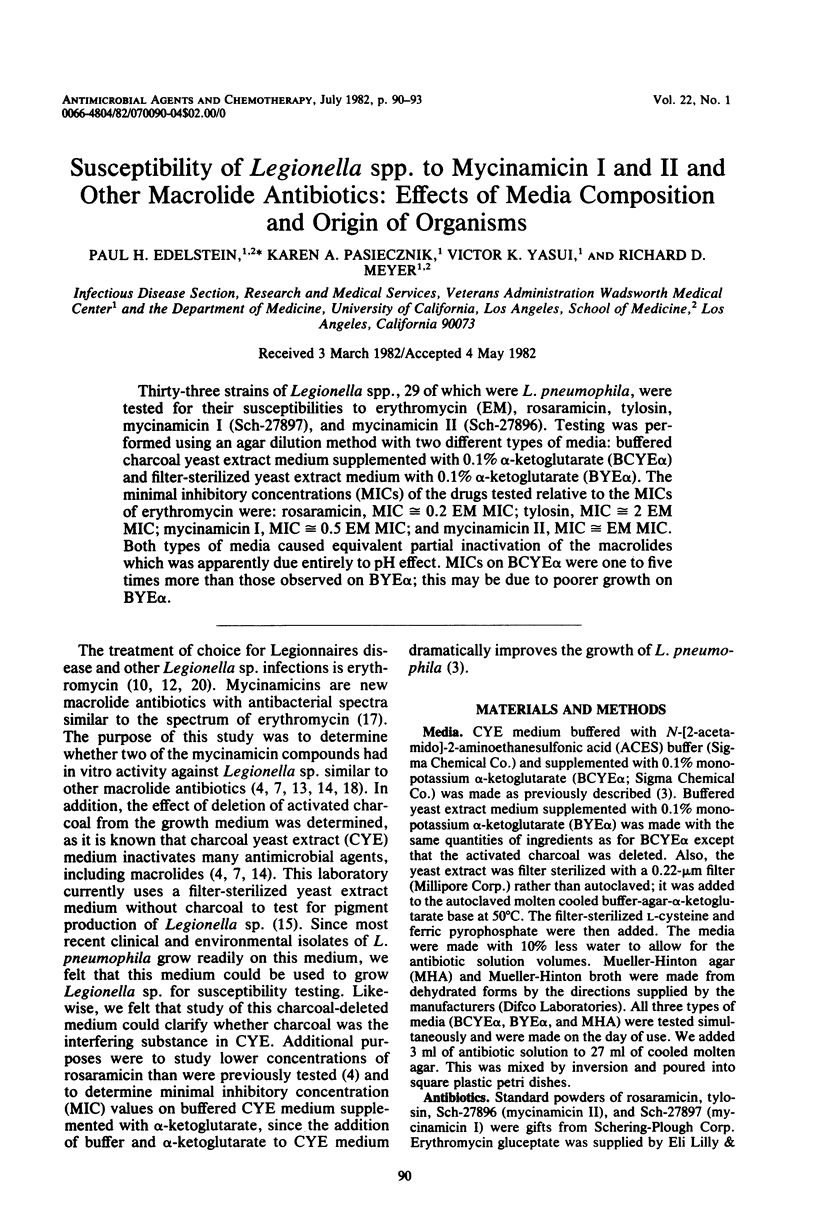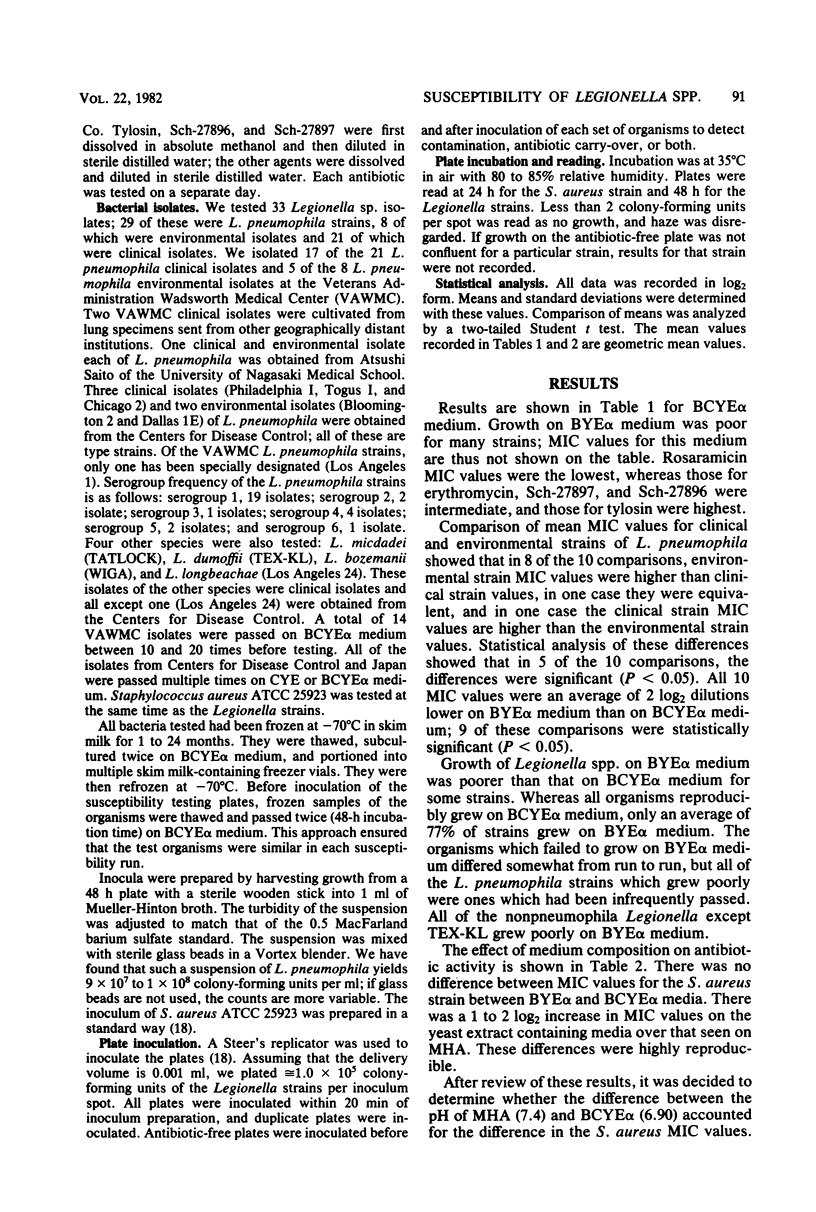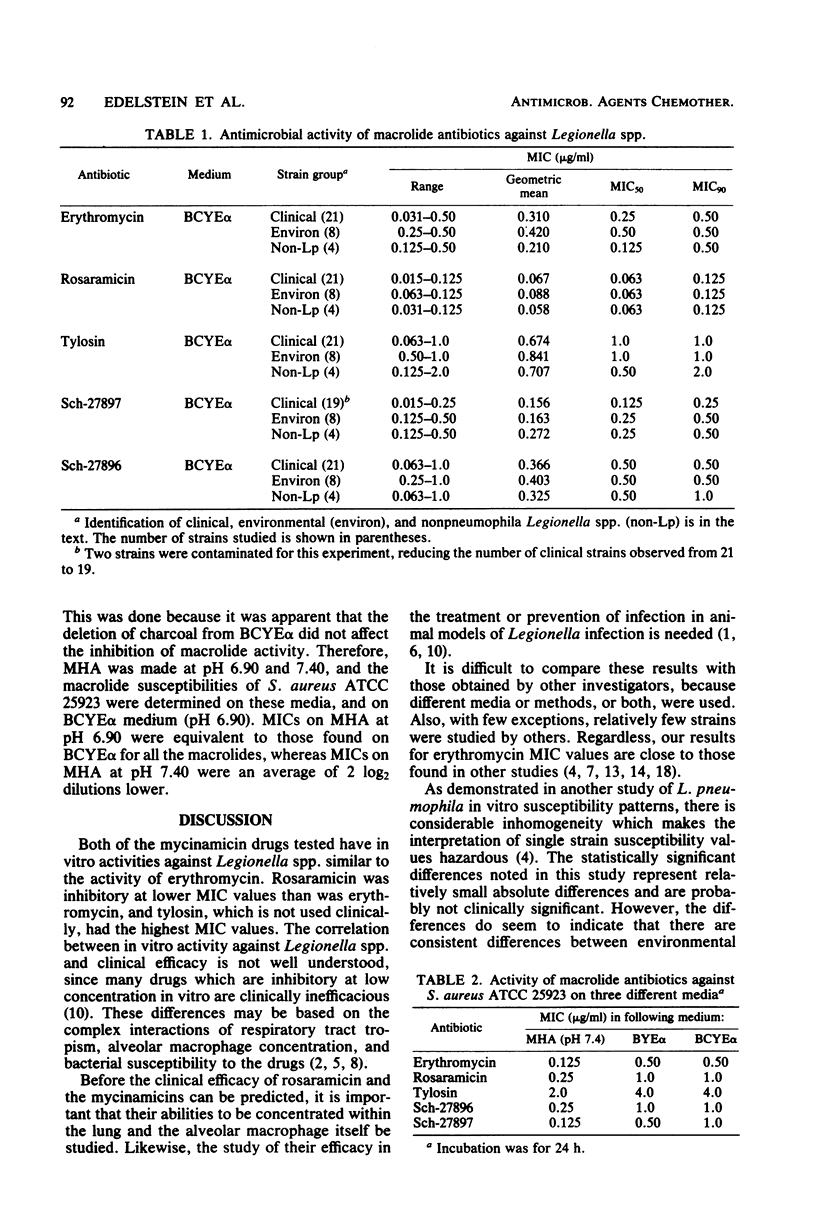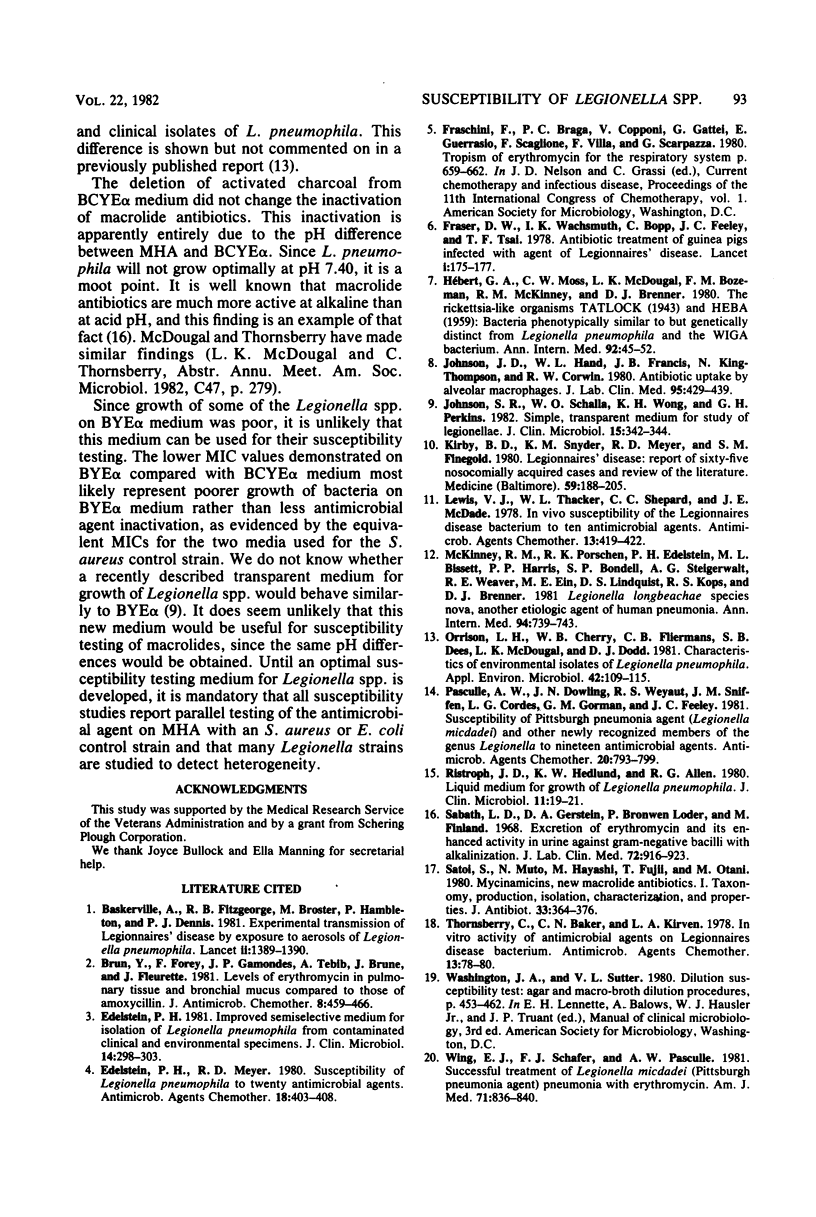Abstract
Thirty-three strains of Legionella spp., 29 of which were L. pneumophila, were tested for their susceptibilities to erythromycin (EM), rosaramicin, tylosin, mycinamicin I (Sch-27897), and mycinamicin II (Sch-27896). Testing was performed using an agar dilution method with two different types of media: buffered charcoal yeast extract medium supplemented with 0.1% alpha-ketoglutarate (BCYE alpha) and filter-sterilized yeast extract medium with 0.1% alpha-ketoglutarate (BYE alpha). The minimal inhibitory concentrations (MICs) of the drugs tested relative to the MICs of erythromycin were: rosaramicin, MIC approximately equal to 0.2 EM MIC; tylosin, MIC approximately equal to 2 EM MIC; mycinamicin I, MIC approximately equal to 0.5 EM MIC; and mycinamicin II, MIC approximately equal to EM MIC. Both types of media caused equivalent partial inactivation of the macrolides which was apparently due entirely to pH effect. MICs on BCYE alpha were one to five times more than those observed on BYE alpha; this may be due to poorer growth on BYE alpha.
Full text
PDF



Selected References
These references are in PubMed. This may not be the complete list of references from this article.
- Brun Y., Forey F., Gamondes J. P., Tebib A., Brune J., Fleurette J. Levels of erythromycin in pulmonary tissue and bronchial mucus compared to those of amoxycillin. J Antimicrob Chemother. 1981 Dec;8(6):459–466. doi: 10.1093/jac/8.6.459. [DOI] [PubMed] [Google Scholar]
- Edelstein P. H. Improved semiselective medium for isolation of Legionella pneumophila from contaminated clinical and environmental specimens. J Clin Microbiol. 1981 Sep;14(3):298–303. doi: 10.1128/jcm.14.3.298-303.1981. [DOI] [PMC free article] [PubMed] [Google Scholar]
- Edelstein P. H., Meyer R. D. Susceptibility of Legionella pneumophila to twenty antimicrobial agents. Antimicrob Agents Chemother. 1980 Sep;18(3):403–408. doi: 10.1128/aac.18.3.403. [DOI] [PMC free article] [PubMed] [Google Scholar]
- Fraser D. W., Wachsmuth I., Bopp C., Feeley J. C., Tsai T. F. Antibiotic treatment of guinea-pigs infected with agent of Legionnaires' disease. Lancet. 1978 Jan 28;1(8057):175–178. doi: 10.1016/s0140-6736(78)90611-6. [DOI] [PubMed] [Google Scholar]
- Hébert G. A., Moss C. W., McDougal L. K., Bozeman F. M., McKinney R. M., Brenner D. J. The rickettsia-like organisms TATLOCK (1943) and HEBA (1959): bacteria phenotypically similar to but genetically distinct from Legionella pneumophila and the WIGA bacterium. Ann Intern Med. 1980 Jan;92(1):45–52. doi: 10.7326/0003-4819-92-1-45. [DOI] [PubMed] [Google Scholar]
- Johnson J. D., Hand W. L., Francis J. B., King-Thompson N., Corwin R. W. Antibiotic uptake by alveolar macrophages. J Lab Clin Med. 1980 Mar;95(3):429–439. [PubMed] [Google Scholar]
- Johnson S. R., Schalla W. O., Wong K. H., Perkins G. H. Simple, transparent medium for study of legionellae. J Clin Microbiol. 1982 Feb;15(2):342–344. doi: 10.1128/jcm.15.2.342-344.1982. [DOI] [PMC free article] [PubMed] [Google Scholar]
- Kirby B. D., Snyder K. M., Meyer R. D., Finegold S. M. Legionnaires' disease: report of sixty-five nosocomially acquired cases of review of the literature. Medicine (Baltimore) 1980 May;59(3):188–205. [PubMed] [Google Scholar]
- Lewis V. J., Thacker W. L., Shepard C. C., McDade J. E. In vivo susceptibility of the Legionnaires disease bacterium to ten antimicrobial agents. Antimicrob Agents Chemother. 1978 Mar;13(3):419–422. doi: 10.1128/aac.13.3.419. [DOI] [PMC free article] [PubMed] [Google Scholar]
- McKinney R. M., Porschen R. K., Edelstein P. H., Bissett M. L., Harris P. P., Bondell S. P., Steigerwalt A. G., Weaver R. E., Ein M. E., Lindquist D. S. Legionella longbeachae species nova, another etiologic agent of human pneumonia. Ann Intern Med. 1981 Jun;94(6):739–743. doi: 10.7326/0003-4819-94-6-739. [DOI] [PubMed] [Google Scholar]
- Orrison L. H., Cherry W. B., Fliermans C. B., Dees S. B., McDougal L. K., Dodd D. J. Characteristics of environmental isolates of Legionella pneumophila. Appl Environ Microbiol. 1981 Jul;42(1):109–115. doi: 10.1128/aem.42.1.109-115.1981. [DOI] [PMC free article] [PubMed] [Google Scholar]
- Pasculle A. W., Dowling J. N., Weyant R. S., Sniffen J. M., Cordes L. G., Gorman G. M., Feeley J. C. Susceptibility of Pittsburgh pneumonia agent (Legionella micdadei) and other newly recognized members of the genus Legionella to nineteen antimicrobial agents. Antimicrob Agents Chemother. 1981 Dec;20(6):793–799. doi: 10.1128/aac.20.6.793. [DOI] [PMC free article] [PubMed] [Google Scholar]
- Ristroph J. D., Hedlund K. W., Allen R. G. Liquid medium for growth of Legionella pneumophila. J Clin Microbiol. 1980 Jan;11(1):19–21. doi: 10.1128/jcm.11.1.19-21.1980. [DOI] [PMC free article] [PubMed] [Google Scholar]
- Sabath L. D., Gerstein D. A., Loder P. B., Finland M. Excretion of erythromycin and its enhanced activity in urine against gram-negative bacilli with alkalinization. J Lab Clin Med. 1968 Dec;72(6):916–923. [PubMed] [Google Scholar]
- Satoi S., Muto N., Hayashi M., Fujii T., Otani M. Mycinamicins, new macrolide antibiotics. I. Taxonomy, production, isolation, characterization and properties. J Antibiot (Tokyo) 1980 Apr;33(4):364–376. doi: 10.7164/antibiotics.33.364. [DOI] [PubMed] [Google Scholar]
- Thornsberry C., Baker C. N., Kirven L. A. In vitro activity of antimicrobial agents on Legionnaires disease bacterium. Antimicrob Agents Chemother. 1978 Jan;13(1):78–80. doi: 10.1128/aac.13.1.78. [DOI] [PMC free article] [PubMed] [Google Scholar]
- Wing E. J., Schafer F. J., Pasculle A. W. Successful treatment of Legionella micdadei (Pittsburgh pneumonia agent) pneumonia with erythromycin. Am J Med. 1981 Nov;71(5):836–840. doi: 10.1016/0002-9343(81)90376-4. [DOI] [PubMed] [Google Scholar]


